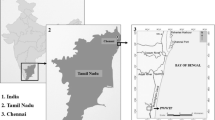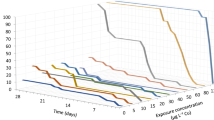Abstract
This study set out to determine the suitability of the nematode Steinernema feltiae as a bioindicator for heavy metal pollution, specifically chromium VI. Nematodes were introduced into sand contaminated with concentrations of Cr VI+, in a range between 10 and 100 ppm, in increments of 10. Reproductive potential, development times and infectivity vs exposure times to Cr VI were employed as endpoints. It was observed that infective juveniles (IJ) from this nematode can survive and successfully infect host insects in the presence of Cr VI for as much as 13 days, and that the nematode increases its reproductive potential at concentrations up to 100 ppm Cr VI+. Conversely, development times (time in days taken for progeny to emerge after larval host death) and IJ infectivity rates were observed to reduce with increasing concentrations of Cr VI. The ability of this nematode to survive in the presence of high concentrations of Cr VI, and its ability to increase progeny numbers at the early stages of Cr VI exposure may provide a survival advantage for this nematode at contaminated sites. It may also demonstrate potential for development as a model species for toxicological assessment in in-situ field sampling.













Similar content being viewed by others
References
American society of testing and materials - ASTM E2172-01 (2014). Standard guide for conducting laboratory soil toxicity tests with the nematode Caenorhabditis elegans. ASTM International, West Conshohocken, PA, USA, 2014. http://www.astm.org
Anderson GL, Boyd WA, Williams PL (2001) Assessment of sub-lethal endpoints for toxicity testing with the nematode Caenorhabditis elegans. Environ Toxicol Chem 20(4):833–838
Bakonyi G, Nagy P, Kadar In (2003) Long term affects of heavy metals and microelements on nematode assemblages. Toxicol Lett 140-141:391–401
Balasubramanian S, Pugalenthi V (1999) Determination of total chromium in tannery waste water by inductivity coupled with plasma-atomic emission spectrometry, flame atomic absorption spectrometry and UV-visible spectrophotometric methods. Talanta 50:457–467
Barceloux D (1999) Chromium. Clinic Toxicol 37(2):173–194
Black MC, Williams PL (2001) Preliminary assessment of metal toxicity in the middle Tisza River (Hungary) flood plain. J Soils Sed 1(4):213–216
Boemare NE, Akhurst RJ (1990) Physiology of phase variation in Xenorhabdus pp. Proc Int Colloq Invert Pathol Micro Control 5:208–212
Bongers T, Ferris H (1999) Nematode community structure as a bioindicator in environmental monitoring. Trends Evol Ecol 14:224–228
Boyd WA, Stringer VA, Williams PL (2001) Metal LC50’s of a soil nematode compared to published earthworm data. In: Greenberg BM, Hull RN, Roberts Jr. MH, Gensemer RW Eds Environmental toxicology and risk assessment: science, policy, and standardisation—implications for environmental decisions: tenth volume, ASTM STP 1403. American Society for Testing and Materials, West Conshohocken, PA, p 2001
Boyd WA, Williams PL (2003a) Availability of metals to the nematode Caenorhabditis elegans: toxicity based on total concentrations in soil and extracted fractions. Environ Toxicol Chem 22(5):1100–1106
Boyd WA, Williams PL (2003b) Comparison of the sensitivity of three nematode species to copper and their utility in aquatic and soil toxicity species. Environ Toxicol Chem 22(11):2768–2774
Boyle S, Kakouli-Duarte T (2008) The effects of chromium VI on the fitness and on the beta-tubulin genes during in-vivo development of the nematode Steinernema feltiae. Sci Total Environ 404:56–67
Brown RL, Bowman RS, Kieft TL (1994) Microbial effects of nickel and cadmium sorption and transport in vocanic tuff. J Environ Qual 23:723–729
Coleman RN (1988) Chromium toxicity: effects in microorganisms with special reference to the soil matrix. In: Nriagu JO, Nieboer E (Eds) Chromium in natural and human environments. Wiley-InterScience, New York, NY, pp 335–350
Dhawan R, Dusenbery DB, Williams PL (1999) Comparison of lethality, reproduction and behaviour as toxicological endpoints in the nematode Caenorhabditis elegans. J Toxicol Environ Health, Part A 58:451–462
Dillon A, Griffin C, Downes M (1999) Hylobius Interest Group activity report No. 2. Second meeting of the Hylobius Interest Group. National University of Ireland, Maynooth
Donkin SG, Dusenbery DB (1994) Using the Caenorhabditis elegans soils toxicity test to identify factors affecting toxicity of four metal ions in intact soil. Water Air Soil Pollut 78:359–373
Eagon GR (1984) The resistance characteristics of Pseudomonads. Developments in industrial microbiology 25:337–348
Farag AM, May T, Marty GD, Easton M, Harper DD, Little EE, Cleveland L (2006) The effects of chronic chromium exposure on the health of Chinook salmon (Oncorhynchus tshawytscha). Aquat Toxicol 76:246–257
Grewal P, Converse V, Georgis R (1999) Influence of production and bioassay methods on infectivity of two ambush foragers (Nematoda: Steinernematidae). J Invertebr Pathol 73:40–44
Griffin C, Moore J, Downes M (1991) Occurrence of insect-parasitic nematodes (Heterorhabditidae, Steinernematidae) in the Republic of Ireland. Nematologica 37:92–100
Gyedu-Ababio TK, Baird D (2006) Response of meiofauna and nematode communities to increased levels of contaminants in a laboratory microcosm experiment. Ecotoxicol Environ Saf 63:443–450
Harmon SM, Wyatt DE (2008) Evaluation of post-Katrina flooded soils for contaminants and toxicity to the soil invertebrates Eisenia fetida and Caenorhabditis elegans. Chemosphere 70:1857–1864
Hazir S, Stock P, Kaya H, Koppenhofer A, Keskin N (2001) Developmental temperature effects on five geographic isolates of the entomopathogenic nematode Steinernema feltiae (Nematoda: Steinernematidae). J Invertebr Pathol 77:243–250
Hitchcock DR, Black MC, Williams PL (1997) Investigations into using the nematode Caenorhabditis elegans for municipal and industrial wastewater toxicity testing. Arch Environ Contam Toxicol 33:252–260
Jaworska M, Gorczyca A (2000) The effects of metal ions on mortality, pathogenicity and reproduction of entomopathogenic nematodes Steinernema feltiae Filipjev (Rhabditida, Steinernematidae). Pol J Environ Stud 11:517–519
Kammenga JE, Riksen JAG (1996) Comparing differences in species sensitivity to toxicants: phenotypic plasticity versus concentration—response relationships. Environ Toxicol Chem 15:1649–1653
Kammenga JE, Vankoert PHG, Riksen JAG, Korthals GW, Bakker JA (1996) A toxicity test in artificial soil based on the life history strategy of the nematode Plectus acuminates. Environ Toxicol Chem 15:722–727
Khanna N, Cressman III CP, Tatara CP, Williams PL (1997) Tolerance of the nematode Caenorhabditis elegans to pH, salinity and hardness in aquatic media. Arch Environ Contam Toxicol 32:110–114
Korthals GW, van der Ende A, van Megen H, Lexmond TM, Kammenga JE, Bongers T (1996) Short term effects of cadmium, copper, nickel and zinc on soil nematodes from different feeding and life history strategy groups. Appl Soil Ecol 4:107–117
Lewis EE, Shapiro-Ilan DI (2002) Host cadavers protect entomopathogenic nematodes during freezing. J Invert Pathol 81:25–32
Lind DA, Marchal WG, Wathen SA (2006) Basic statistics in business and economics. McGraw-Hill/Irwin, Boston, USA
Lokke H, van Gestel CAM (1998) Handbook of soil invertebrate toxicity tests. John Wiley & Sons, Chichester
Malakhov VV (1994) Nematodes, structure, development, classification and phylogeny. Smithsonian Institution Press, Washington, DC
McGrath D, Carton O, Diamond S, O’Sullivan A, Murphy W, Rogers P, Parle P, Byrne E (2001) Investigation of animal health problems at Askeaton, Co. Limerick: soil, herbage, feed and water. EPA, Johnstown Castle Estate, Wexford, Ireland
Millward RN, Carman KR, Fleeger JW, Gambrell RP, Rodney TP, Rouse M-AM (2001) Linking ecological impact to metal concentrations and speciation: a microcosm experiment using a salt marsh meiofaunal community. Environ Toxicol Chem 20(9):2029–2037
Nagy P, Bakonyi G, Bongers T, Kadar I, Fabian M, Kiss I (2004) Effects of microelements on soil nematode assemblages seven years after contaminating an agricultural field. Sci Environ 320:131–143
Norseth T (1981) The carcinogenicity of chromium. Eviron Health Perspect 40:121–130
O’Brien TJ, Fornsaglio JL, Patierno SR (2002) Effects of hexavalent chromium on the survival and cell cycle distribution of DNA repair-deficient S. cerevisiae. DNA Repair 1:617–627
Parameswari E, Lakshmanan A, Thilagavathi T (2009) Bioasorption of chromium VI and nickel (II) by bacterial isolates from an aqueous solution. Electron J Environ, Agric Food Chem 8(3):150–156
Peredney CL, Williams PL (2000) Utility of Caenorhabditis elegans for assessing heavy metal contamination in artificial soil. Arch Environ Contam Toxicol 39:113–8
Perez E, Lewis E, Shapiro-Ilan D (2004) Effect of application method on fitness of entomopathogenic nematodes emerging at different times. J Nem 36:534–539
Perez-Benito JF (2006) Effects of chromium VI and vanadium V in the lifespan of fish. J Trace Elem Med Biol 20:161–170
Pionar G (1990) Taxonomy and biology of Steinernematidae and Heterhabditidae. In: Gaugler R, Kaya HK (eds) Entomopathogenic nematodes in biological control, CRC Press Boca Raton, FL, USA, pp 23–61
Richard FC, Bourg ACM (1991) Aqueous geochemistry of chromium: a review. Water Res 25:807–816
Rocchetta I, Mazzuca M, Conforti V, Ruiz L, Balzaretti V, del Carmen Rios de Molina M (2006) Effects of chromium on the fatty acid composition of two strains of Euglena gracilis. Environ Pollut 141:353–358
Rolston A (2004) Distribution, relatedness, fitness and behaviour of entomopathogenic nematodes from Bull Island, Dublin. PhD thesis. National University of Ireland, Maynooth, Ireland
Ruppert EE, Barnes RD (1994). Invertebrate Zoology, 6th edn. Saunders College Publishing, Harcourt Brace and Company. Orlando, Florida, USA
Shrivastava R, Upreti RK, Seth PK, Chaturvedi UV (2002) Effects of chromium on the immune system. FEMS Immun Med Micro 34:1–7
Sochova I, Hofman J, Holoubek I (2007) Effects of seven organic pollutants on soils nematode Caenorhabditis elegans. Environ Intern 33:798–804
Sorensen MA, Jensen PD, Walton WE, Trumble JT (2006) Acute and chronic activity of perchlorate and hexavalent chromium contamination on the survival and development of Culex quinquefasciatus Say (Diptera: Culicidae). Environ Pollut 144:759–764
Sivakumar S, Subbhuraam V (2005) Toxicity of chromium(III) and chromium(VI) to the earthworm Eisenia fetida. Ecotoxicol Environ Saf 62:93–98
Van Gestel CAM, van Straalen NM (1994) Ecotoxicological test systems for terrestrial invertebrates. In: Donker MH, Eijsackers H, Heimback F (eds) Ecotoxicology of soil organisms. CRC Press, Inc., Boca Ranton, pp 205–228
van Straalen NM, Van Gestel CAM (1993) Soil invertebrates and microorganisms. In: Calow P (ed) Handboook of ecotoxicology, Vol. 1. Blackwell Publishing. Oxford, UK, pp 251–276
Vasanthy M (2004) An investigation on removal of chromium VI using bacterial strains. Asian J Microbiol Biotech Env Sci 7(1):38–46
van Vliet CJ, de Goede GM (2008) Nematode-based risk assessment of mixture toxicity in a moderately polluted river floodplain in the Netherlands. Sci Total Environ 406:449–454
Velma v, Vutukuru S, Tchounwou p (2009) Ecotoxicology of Hexavalent Chromium in Freshwater Fish: A Critical Review. Rev Envrion Health 24(2):129–145
Wang DY, Wang Y (2008) Phenotypic and behavioural defects caused by Barium exposure in nematode Caenorhabditis elegans. Arch Environ Contam Toxicol 54:447–453
Weiss B, Larink O (1991) Influence of sewage sludge and heavy metals on nematodes in an arable soil. Biol Fert Soils 12:5–9
Williams P, Dusenbery D (1990) Aquatic toxicity testing using the nematode Caenorhabditis elegans. Environ Toxicol Chem 9:1285–1290
WHO Document (2000) Chapter 6.4; chromium. Air Quality Guidelines. World Health Organsiation Regional Office for Europe, Copenhagen, Denmark
Womersley CZ (1993) Factors affecting physiological fitness and modes of survival employed by dauer juveniles and their relationship to pathogenicity. In: Bedding R, Akhurst R, Kaya H (eds.) Nematodes and the biological control of insect pests. CSIRO, East Melbourne, Victoria, Australia, pp 79–88
White G (1927) A method for obtaining infective nematode larvae from cultures. Science 66:302
Yoder C, Grewal P, Taylor A (2004) Rapid age-related changes in infection behaviour of entomopathogenic nematodes. J Parasitol 90:1229–1234
Acknowledgements
This project was funded by the Environmental Protection Agency (EPA) Ireland under the ERTDI Postdoctoral Fellowship Programme, Ref No: 2008-FS-28-M1 and the STRIVE programme 2006–2013. The authors would like to thank Ms. Laura Mestre Alvarez for her invaluable assistance with the laboratory work. We also wish to thank the anonymous reviewers for the interesting and challenging comments.
Author information
Authors and Affiliations
Corresponding author
Ethics declarations
Conflict of interest
The authors declare that they have no conflict of interest.
Ethical approval
This article does not contain any studies with human participants or animals performed by any of the authors.
Informed consent
No informed consent was required for this reported work.
Rights and permissions
About this article
Cite this article
Boyle, S., Kakouli-Duarte, T. The behaviour of the nematode, Steinernema feltiae (Nematoda: Steinernematidae) in sand contaminated with the industrial pollutant chromium VI. Ecotoxicology 27, 590–604 (2018). https://doi.org/10.1007/s10646-018-1932-6
Accepted:
Published:
Issue Date:
DOI: https://doi.org/10.1007/s10646-018-1932-6




